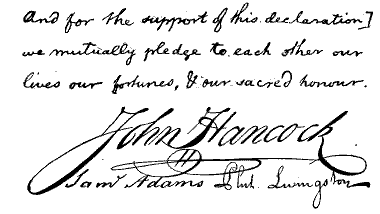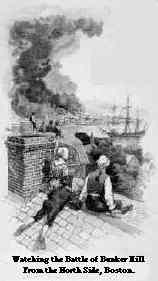Resource Center OLLibrary
|
146 |
|
[1775 |
|
|

FRANKLIN'S LETTER TO
STRAHAN
|
148 |
|
[1775-1776 |
|
|
|
1775 ] |
|
149 |
|
The following day Washington entered
Boston in triumph. The British had left it never to
|
|
150 |
|
[1776 |
The very day that proclamation came, a
remarkable pamphlet was published in Philadelphia. It was entitled
"Common Sense." The writer was Thomas Paine, an Englishman who had
come here to live. He boldly said that the time had come for a
"final separation" from England, and that "arms must decide the
contest." The pamphlet sold by tens of thousands, because it gave
voice to what tens of thousands were thinking.
The English people would not volunteer to fight
the Americans, and the King had to hire nearly 30,000 Hessians,
from the Prince of Hesse in Germany, to help do the work. The
knowledge of that fact cut the last thread that held us bound to
the mother country. The Americans had not sought separation; the
King -- not the English people -- had forced it on them.
167. The Declaration of Independence. In
June, 1776, Richard Henry Lee of Virginia offered this resolution
in the Continental

REDUCED COPY OF
THE LAST LINE
OF THE DECLARATION
OF INDEPENDENCE
(IN
JEFFERSON'S
HANDWRITING) WITH
THE FIRST
THREE
SIGNATURES
Congress which was sitting in the Old State House in
Philadelphia: "Resolved: that these United Colonies are, and of
right ought to be, FREE AND INDEPENDENT STATES." John Adams of
Massachusetts seconded the resolution. A committee of five --
Thomas Jefferson of Virginia, John Adams of
Massachusetts,

THOMAS JEFFERSON
 In
an hour and a half the British lost over 1000 men out of
3000. The American loss was somewhat less than half as
much.1 During the engagement Howe ordered
Charlestown to be fired, and by night the greater part of
the town was in ashes.
In
an hour and a half the British lost over 1000 men out of
3000. The American loss was somewhat less than half as
much.1 During the engagement Howe ordered
Charlestown to be fired, and by night the greater part of
the town was in ashes. Benedict
Arnold of Connecticut, one of the bravest soldiers of the
Revolution, started with over 1000 men to join in the
attack. Setting out from Newburyport, Massachusetts,
Arnold undertook to make his way from the mouth of the
Kennebec through the forests of Maine. He was six weeks
getting across the wilderness. The suffering was so
terrible that many men deserted, and the rest, after
having been compelled to eat their moccasins, nearly
perished.
Benedict
Arnold of Connecticut, one of the bravest soldiers of the
Revolution, started with over 1000 men to join in the
attack. Setting out from Newburyport, Massachusetts,
Arnold undertook to make his way from the mouth of the
Kennebec through the forests of Maine. He was six weeks
getting across the wilderness. The suffering was so
terrible that many men deserted, and the rest, after
having been compelled to eat their moccasins, nearly
perished. return.
With them went about a thousand Tories, as those
Americans were called who opposed the war and wished to
submit to the King (§ 160).
return.
With them went about a thousand Tories, as those
Americans were called who opposed the war and wished to
submit to the King (§ 160). 166.
"Common Sense"; the Americans decide to separate from
Great Britain. Up to 1776 the Americans had been
fighting in defense of their rights as English subjects.
Washington said, "When I first took command of the
Continental army I abhorred the idea of independence."
But in January (1776) the King's proclamation reached
Congress. In it he called for troops to put down "the
rebellion" in America. That was the only answer he gave
to their humble petition for justice (§ 160).
166.
"Common Sense"; the Americans decide to separate from
Great Britain. Up to 1776 the Americans had been
fighting in defense of their rights as English subjects.
Washington said, "When I first took command of the
Continental army I abhorred the idea of independence."
But in January (1776) the King's proclamation reached
Congress. In it he called for troops to put down "the
rebellion" in America. That was the only answer he gave
to their humble petition for justice (§ 160).


